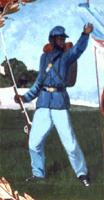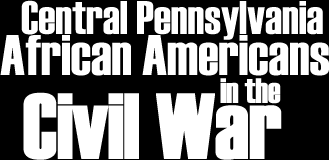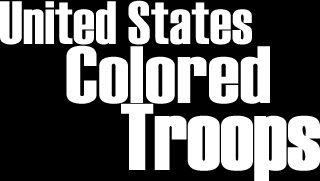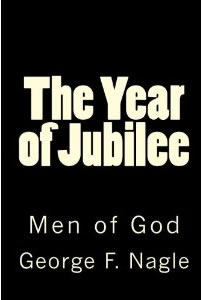

The Civil War affected the African American community in central Pennsylvania in many ways. Confederate invasions caused upheaval in all communities as free citizens, former fugitive slaves, and "contrabands," slaves who fled north as Union troops liberated their homes, scrambled to get away from advancing Rebels who they feared would capture them and take them south into slavery.
Study Areas:
Anti-Slavery
Others contributed to the war effort in many ways: by raising aid for soldiers, working in camps and hospitals, recruiting men for the new African American regiments, and by enlisting to serve in those regiments.
 These pages will document the varied contributions of African Americans to the war effort in central Pennsylvania.
These pages will document the varied contributions of African Americans to the war effort in central Pennsylvania.
Sunday, October 17, 2010
A Page From Harrisburg History
My article below appeared in The Patriot-News' Opinion pages on October
17, 2010.
Harrisburg’s sesquicentennial year as a city will close in a few weeks with a final fanfare centering on the one hundred and forty-fifth anniversary of the Grand Review of Colored Troops. The original event, which took place in November 1865, featured a parade by African American troops returning home following the Civil War. Racism had denied these troops a spot in the official Grand Review in Washington, DC that May, which was staged to celebrate the Union victory. At the behest of the Garnet Equal Rights League of Harrisburg, however, these slighted men were given their due recognition in the capital of the Keystone State, which offered “a Complimentary Reception, a Free Dinner, and an Oration Welcome.”
Realizing that such an event was likely to be ignored by most of the state and city’s white residents, the African American organizers used word of mouth, and advertised in various African American publications, urging “the colored people of Pennsylvania” to “crowd Harrisburg, and give your brothers in blue a thrilling welcome.” Special half-price excursion rates were arranged with agents of the Cumberland Valley, the Philadelphia and Reading, the Northern Central, and the Pennsylvania Central railroads, in hopes of drawing crowds that would send “thundering echoes” of cheering support to the returning soldiers. The grassroots effort worked magnificently, and in mid-November, the black residents of the City of Harrisburg, along with hundreds of visitors, paid homage to black veterans with a parade, speeches, and a free dinner at the Soldier’s Rest.
This was not the first time that Harrisburg’s African American community had come together during a time of need. Historically, blacks in Harrisburg have a strong tradition of opening their doors to fighters in the war on inequality, and of pulling together to fight the ravaging brutalities of hatred and ignorance. An early example occurred in April 1825, when “a great number of blacks” gathered outside of the courthouse on Market Street to demonstrate against the recapture of a fugitive slave, whose hearing was being conducted inside. Although they did not succeed in gaining freedom for the captured slaves, their sheer numbers and aggressive behavior clearly intimidated the slave hunters and set a precedent for future collective action.
Over the course of the next forty years, Harrisburg’s African American residents weathered numerous social, economic, and political storms through the effective employment of mutual aid and self-help. A crisis of will occurred in 1859, however, that threatened to tear the black community apart. For several years, fugitive slaves and newly-freed blacks had been arriving in town in large numbers. Although local black residents tried to absorb and accommodate these newcomers, a shortage of good housing and employment threatened to overwhelm this traditionally tight-knit community.
A vital pressure release had been lost in 1857 with the purchase of the land north of Tanner’s Alley by developer William Verbeke. No longer could new arrivals take up a squatter’s residence on the vacant land next to the burgeoning black neighborhood. The result, by 1859, was a neighborhood constrained on all sides and bursting at the seams. In addition, Harrisburg’s longtime black residents found it difficult to bond with the new, unskilled, illiterate refugees from the South. For the first time, Harrisburg’s African American community found itself divided into two competing camps, with little in common. The rift came at a bad time, as slave catchers were again becoming more aggressive. Now more than ever, a cohesive community was vital for everyone’s survival.
In April 1859, four slave catchers cornered Daniel Dangerfield in one of the market sheds on the square. With Colt revolvers drawn against the gathering crowd, they hustled their captive off to the Pennsylvania Railroad Station, where they took the train to Philadelphia for his hearing. Although the case received much attention in the newspapers, the outlook appeared grim for Dangerfield. It was at that point that Carlisle native and abolitionist J. Miller McKim sent an urgent telegram to Harrisburg seeking help. Harrisburg responded.
In the late afternoon of the second day of the hearing, five African American men from Harrisburg pushed their way through the hostile white crowd that surrounded the hearing room. Leading the way was sixty-six-year-old William Jones, one of the town’s most respected African American citizens. Testimony and cross-examination lasted for more than three hours, with Jones telling how Daniel Dangerfield has helped him dig the cellar of his rooming house on West Alley in 1853. Prosecutors attempted to confuse Jones with a battery of detailed questions, but the old man’s memory proved faultless. Ultimately, Dangerfield was freed.
William Jones had secured the freedom of Daniel Dangerfield, but more importantly, he had provided the foundation upon which Harrisburg’s African American community would again make itself whole. He had proved the power of African American memory and legacy--an idea which was seized upon the following August by Jacob C. White, Jr., in a speech before an assembled African American crowd in a local picnic grove. Enslaved, hunted, disenfranchised, proscribed, and segregated by their white neighbors, and now declared non-citizens by the highest court in the land, African Americans from North and South had a common struggle, a common heritage, and a legacy of mutual aid, according to White. That was the motive that drove William Jones to travel hours to testify for a man before a hostile court, and that was the motive that would enable Harrisburg’s African American community to survive the coming years of civil war.
During this Sesquicentennial year, Harrisburg is again facing a crisis of will. Debt and internal squabbling threaten to undermine all aspects of city operations. Harrisburg’s African American community, in particular, can draw from a rich heritage of mutual aid and dozens of inspiring, even heroic episodes. In decades past, Harrisburg blacks have surmounted and conquered obstacles of staggering magnitude. Yet much of this noble legacy has escaped the history books. Residents, estranged from their historical roots, must feel like Dunne’s fictional Mr. Dooley, who lamented “I know histhry isn't thrue, Hinnessey, because it ain't like what I see ivery day in Halstead Street.” If Harrisburg is to remain a vibrant community, it is vital that residents reestablish their historical memory. Whether black or white, it is a mutual history, and one of which all can be justly proud.

Read the book!
Full text availabale on this site.
Click the cover image to read it.
Support the Afrolumens Project!
